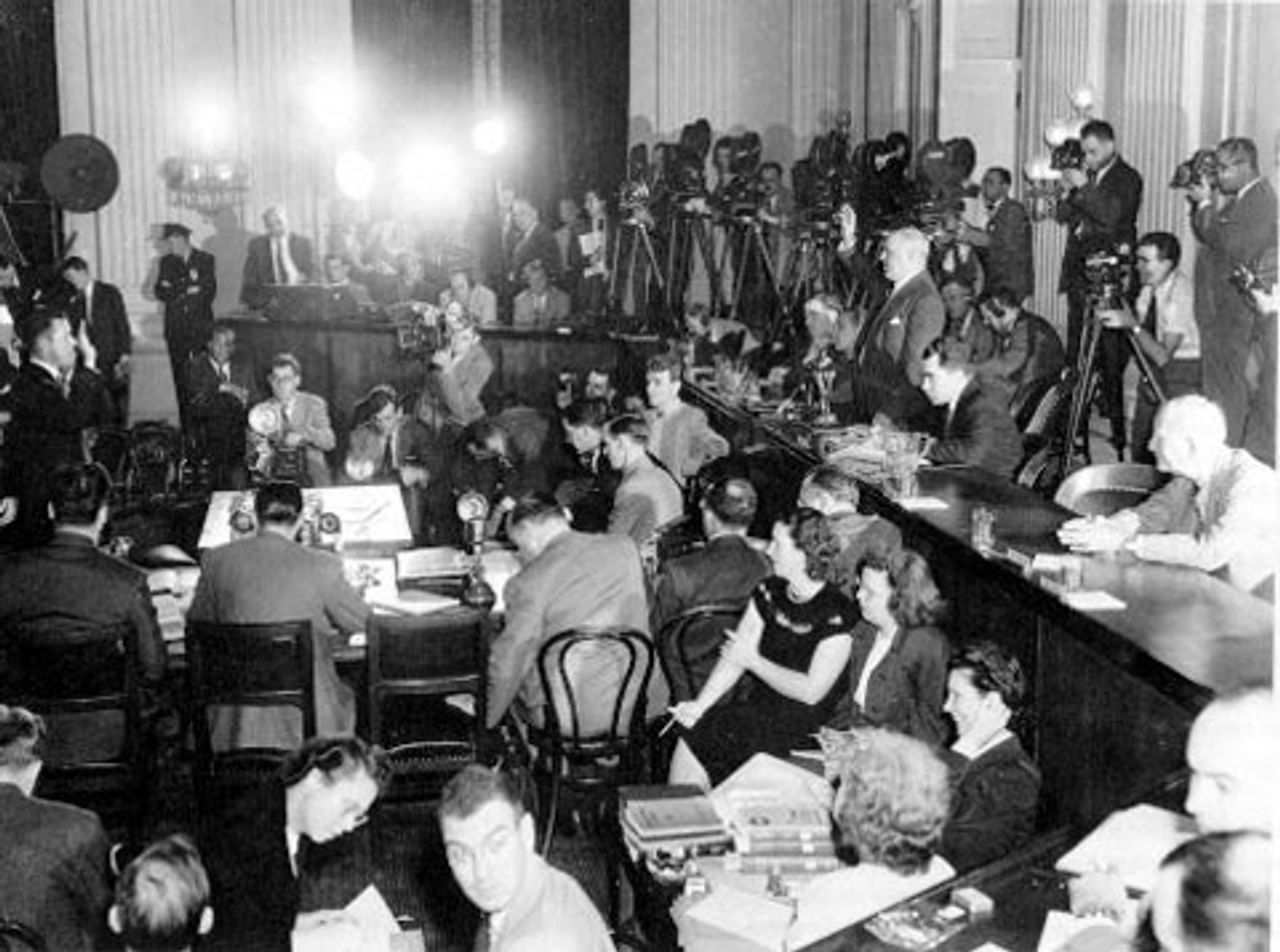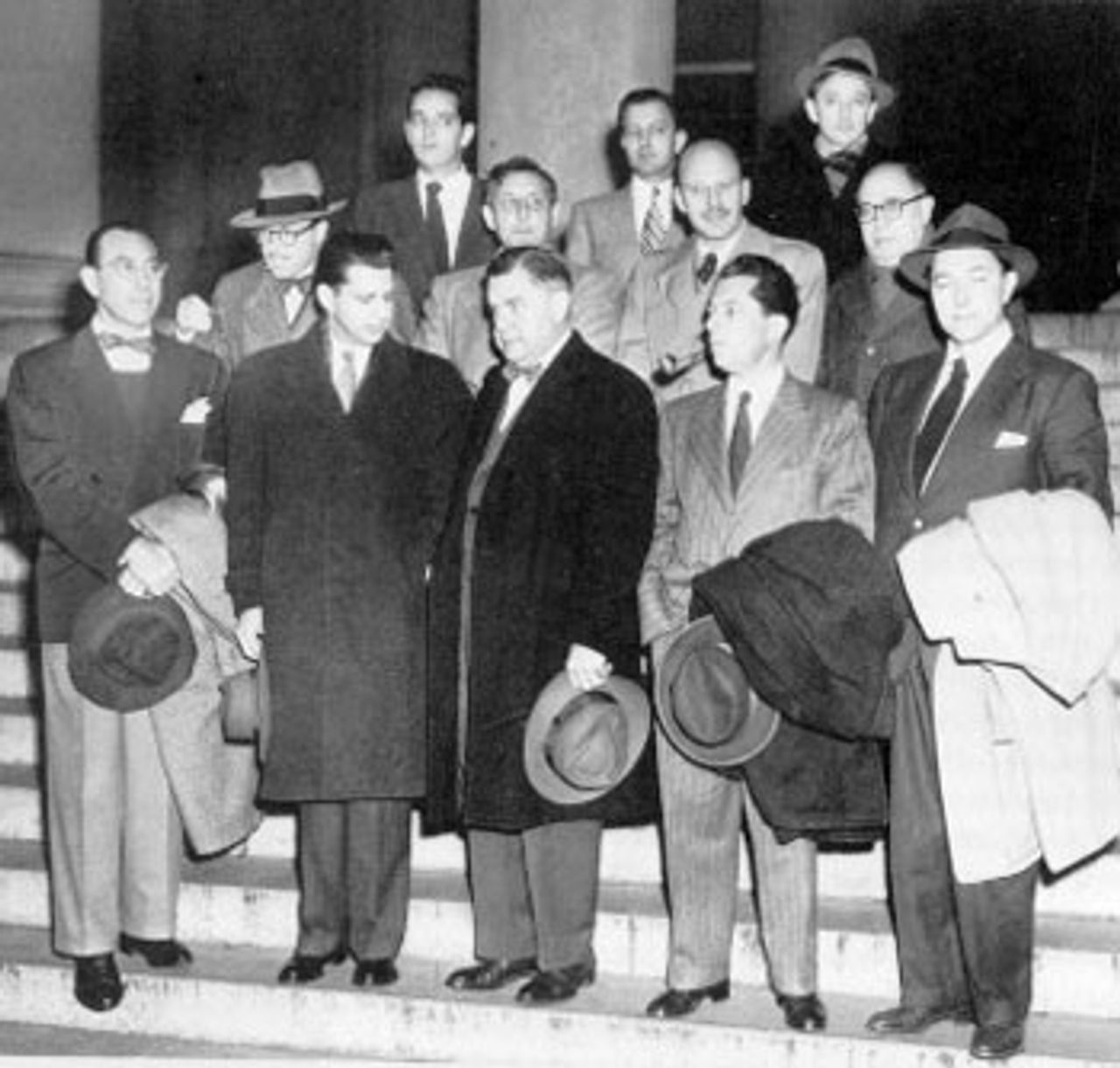Hollywood on Trial (1976) directed by Daniel Halpern, Jr., written by Arnie Riesman, cinematography by Barry Abrams, narration by John Huston
The Hollywood witchhunt and blacklisting of left-wing actors, writers and directors in the post-World War II period has been the subject of many books, but has received little serious attention in Hollywood itself.
 HUAC hearings — 1951-53
HUAC hearings — 1951-53The Front, Martin Ritt’s 1976 film starring Woody Allen, is a humorous effort with some serious insights. Other films concerned with the blacklist or McCarthyism in general include Guilty by Suspicion (1991), The Majestic (2001), Good Night, and Good Luck (2005), and the television film Tail Gunner Joe (1977). The list is shamefully short.
More recently, in 2007, the worthwhile but limited documentary Trumbo appeared, based on letters from screenwriter Dalton Trumbo who was one of the Hollywood Ten, the writers and directors who were cited for contempt of Congress and blacklisted in 1947 for refusing to testify, on First Amendment grounds, before the witchhunting House Un-American Activities Committee (HUAC).
The only effort to deal in some detail and in documentary form with the history of the HUAC hearings in this period is the 1976 film Hollywood on Trial.
There is much valuable material in this movie. The footage in some cases speaks for itself, showing the Congressional witchhunters at work.
The film exposes the myth commonly subscribed to that the witchhunt was the product of a few flawed individual minds, specifically those of the redbaiting Senator from Wisconsin, Joe McCarthy, and the California Congressman who went on to become president of the United States some two decades later, Richard Nixon.
 Senator Joseph McCarthy
Senator Joseph McCarthyWhile McCarthy and Nixon were notorious for playing the anti-communist card throughout their despicable political careers, they were only two among other prominent players in these events, and neither played a leading role in the Hollywood events. The witchhunt represented the policy of the American ruling class, not simply one or more of its political representatives.
The film contains a few shots of Nixon sitting mutely on the interrogating panel in 1947, as a junior representative would be expected to do. He had just entered the House of Representatives, and would not become prominent until the Hiss-Chambers espionage case, in 1948. As for McCarthy, as a senator he played no role at all in the HUAC hearings, which took place in the other house of the US Congress. He appears only briefly in the film, ranting to the press about communists allegedly infesting Hollywood.
The documentary’s most valuable service is in dispelling the superficial and mistaken conception that the anti-communist hearings arose suddenly in conjunction with the post-World War II Cold War, and just as suddenly disappeared without leaving a trace.
In fact, although HUAC became a permanent body in 1945, its origins go back to the 1930s and even further, to a Congressional committee that began investigating Bolshevism after the 1917 Russian Revolution.
Texas Democratic Congressman Martin Dies used his position on the Un-American Activities Committee to attack the Roosevelt New Deal in the late 1930s. During the Committee’s 1938 hearings on the Works Progress Administration (WPA), he and others accused the Federal Theater Project of dangerous left-wing sympathies. Dies’ real opponent was not Roosevelt so much as the American working class, then engaged in massive battles that were in many instances led by socialists and communists. On this and many other occasions, the Roosevelt Administration accommodated or even assisted the witchhunters.
 Director John Huston
Director John HustonHollywood on Trial contains archival footage on some of the labor battles of the 1930s, the impact of the Depression on social and political conditions in the US, and international developments such as the Spanish Civil War. Narrator John Huston, the veteran Hollywood director (who died in 1987), explains that many radicalized American workers joined the Communist Party because they saw it as the only force fighting against the growing threat of fascism.
After the war, the anticommunist campaigners took the offensive as the American ruling elite, having defeated German imperialism, shifted its attention to the Soviet Union and launched the Cold War in its campaign for unchallenged global hegemony.
While the footage in the film of the two rounds of HUAC hearings, the first beginning in 1947 and the second in 1951, is at times of poor quality, the scenes do reveal the essence of the anticommunist witchhunts. They capture the sometimes circus-like atmosphere of the proceedings, as well as the way in which Hollywood bigwigs joined the witchhunt and helped to victimize some of the most talented figures in the industry.
 Rep. J. Parnell Thomas
Rep. J. Parnell ThomasCommittee Chairman J. Parnell Thomas of New Jersey is heard shouting, “Are you now, or have you ever been, a member of the Communist Party?” throughout the first round of hearings. Thomas, incidentally, soon faced his own legal problems. He was imprisoned on fraud charges in 1950, but the witchhunt continued, for the time being presided over by Georgia Democrat John S. Wood.
The camera catches Lauren Bacall and Humphrey Bogart, leading Hollywood liberals active in the Committee for the First Amendment, leaning forward as witnesses testify. The so-called friendly witnesses, who agreed either to denounce left-wing influence or even identify those in Hollywood whom they suspected or claimed to know as members of the Communist Party, included actor Robert Taylor, a willing provider of hearsay evidence, which was later used to obtain convictions. Gary Cooper appeared quite comfortable with his own ignorance, bragging to the Committee, “I haven’t read Marx, but from what I hear, I don’t like him.”
 Lauren Bacall and Humphrey Bogart outside the HUAC proceedings
Lauren Bacall and Humphrey Bogart outside the HUAC proceedingsThis is followed by confrontations between the Committee and the 19 “unfriendly” witnesses, those subpoenaed to appear, but who refused to respond to questions concerning their political affiliation. Here the police-state character of the proceedings becomes very apparent, with unfriendly witnesses being hauled out of the hearings by the police for refusing to answer the witchhunters and standing up to their threats and intimidation.
A group of these witnesses, later named the Hollywood Ten, joined together to challenge the Committee on the basis of their First Amendment rights. They proved unsuccessful. Huston explains that the Supreme Court had moved to the right, refusing to hear the appeal of the Hollywood Ten after their conviction for contempt. The Hollywood studios went along with the witchhunt without resistance.
On November 24, 1947 Congress voted overwhelmingly to cite the Ten for contempt. The next day Eric Johnston, the president of the Motion Picture Association of America, held a press conference to announce that all ten of those indicted were fired and would not be reemployed until they swore they were not Communists. This marked the birth of the infamous blacklist, a system that lasted for the next decade and longer. Though centered in Hollywood, it spread to television and other spheres of cultural life.
Interviews with some of the Hollywood Ten reveal the lasting consequences of the witchhunt, at least in personal terms. Director Edward Dmytryk (Crossfire, Caine Mutiny, Raintree County), who named names during the second round of hearings, emerges as a self-serving opportunist.
Others relate stories of being unable to find work for years, and of using “fronts,” writers willing to allow the use of his or her name in the credits while the blacklist victim actually wrote the script. Trumbo (Tender Comrade, Spartacus, Johnny Got His Gun), one of the more gifted and prolific screenwriters of his generation, speaks openly of his genuine “contempt” for Congress and its hearings until the very end (the 1976 interview included in Hollywood on Trial was conducted shortly before his death), but at times he also sounds demoralized.
The blacklist continued unchallenged until the late 1950s. A major break in the Hollywood blacklist did not come until director Otto Preminger announced in 1960 that Trumbo would be the screenwriter of the forthcoming film Exodus. Between 1947 and 1960 Trumbo had authored more than a dozen films for which he had not received credit.
Where Hollywood on Trial comes up seriously short is in its understanding, or lack thereof, of the roots of the blacklist and of the role of various forces that in one way or another surrendered to the witchhunt or allowed it to carry out its destructive work.
Liberalism surrendered to the witchhunt because its class position, within the framework of capitalism, left it powerless to resist the shift in policy that accompanied the Cold War. Some erstwhile liberals were more reluctant and some were fairly enthusiastic in their embrace of the anti-communist crusade, but those who actively resisted were very few and far between. The trade union bureaucracy was vociferous in its endorsement of the witchhunt. None of this is seriously examined in Hollywood on Trial.
The role of the Communist Party also requires serious assessment. On the one hand, the crimes of Stalinism, its brutal attacks on the working class, gave the witchhunters some ammunition. Most importantly, the Stalinist bureaucracy disoriented and demoralized its own supporters, those who mistakenly looked to the Soviet government and the Communist parties in the US and elsewhere as the representative of socialism.
 HUAC hearings — Hollywood Ten — October 1947
HUAC hearings — Hollywood Ten — October 1947During the postwar period the Stalinists tried to encourage the illusion that a return of the Popular Front alliance with liberalism would defend civil liberties and workers’ rights. The legal strategy of the Hollywood Ten flowed from this political outlook. They pinned their hopes on the third-party presidential campaign of former Vice President Henry Wallace. They had subordinated the working class to the Democratic Party and were left high and dry when the Democrats obediently joined the anti-communist campaign.
All of this is beyond the understanding of the makers of this film. Huston and others are no doubt sincere in their opposition to the witchhunt, but nostalgia for the New Deal neither explains the witchhunt of the postwar years nor does it prepare anyone for today’s and tomorrow’s struggles against new attacks on democratic rights.
The most vulgar expression of the limitations of Hollywood on Trial’s perspective is its inclusion of clips from Hollywood productions such as Song of Russia and Mission to Moscow, during World War II. Rather than identifying these films as the wretched pro-Stalinist propaganda pieces they are, the makers of Hollywood on Trial allow the movies’ trailers to describe their themes and subject matter, including the infamous Moscow Trials in Mission to Moscow, with approval.
HUAC was neither the beginning nor the end of anti-communism. In recent decades many in Hollywood have smugly assured themselves that the days of the blacklist were an unfortunate aberration. The aftermath of the events of September 11, 2001 demonstrated the stupidity of such a claim, as new efforts were made to ensure that movies toed a patriotic, pro-war line.
Even earlier, in 1999, the tendency toward the rehabilitation of witchhunting was glaringly displayed in the special Oscar awarded to the notorious informer Elia Kazan. What dominates the upper echelons of the film industry today is not principled opposition to censorship and political persecution, but rather rotten compromise with the most reactionary forces. A political perspective is the prerequisite for a victorious struggle against witchhunting.
Despite the serious weaknesses of Hollywood on Trial there is nevertheless much important raw material in it that will reward the spectator, especially if a viewing is combined with further study on the subject.
The author also recommends:
The anti-communist purge of the American film industry
[4 February 2009]
